Tour essentials: Sûreté du Québec, Commissaires, technical team, volunteers
By: Normand Gosselin
An event of the magnitude of the Tour de l’Abitibi requires the contribution of several hundred people and it is important to note, to talk about these people who, for many, take an important part of their annual vacation to make their contribution to this Tour ahich is the pride of the Abitibians.
Of course, as we sometimes say, money is the nerve of war. Cities, governments, sponsors, and partners that provide goods and services top the list of must-haves. But without the volunteer contribution of so many others, no need to think about it, the Tour would not take place. When we think of the 54 years of life of this international competition, we can hardly imagine the number of thousands of people who have invested their time, money and passion. Paying tribute doesn’t really hurt…
Although there have been books written about the Tour, many interviews on radio and TV, there is so much to say. These few photos are intended to reveal some aspects of this great organization.
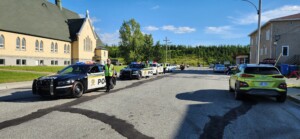
The safety of runners and spectators is of prime importance. Already that it is a risky sport (especially falls and exhaustion), it goes without saying that their safety is the first priority. For 54 years, the Sûreté du Québec has put its knowledge, attention and forecasting skills to work. Many vehicles are also involved: cars, motorcycles, MSV. Many police officers are on duty throughout the Tour.
The members of Sûreté du Québec have recently taught Quebecers a lesson. While their collective contract negotiators had accepted the government’s offers, they rejected these offers by vote and forced their representatives to return to negotiate. The big lesson: no strike (they don’t have the right to strike), only a little bit of public awareness by wearing unconventional clothing given their job, but above all have never denigrated the authorities as others have done constantly since last fall or published unpleasant messages in the media. It earned them public and government respect. They finally got what they wanted.
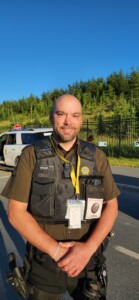
Such an operation requires solid preparation and constant coordination. Sergeant Steve Roussil completed this task this year.
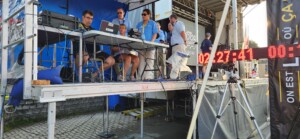
Any sport requires rules and experts to ensure compliance. Even more so when it comes to an international event with athletes from several countries: in addition to Quebec and elsewhere in Canada, the Tour includes teams from the United States, France, Colombia, Mexico, Japan, and New Zealand, China and Israel, who speak languages other than French and English. Commissaires must be understood by all, especially when making decisions in situations that may require interpretation.

We see Maurice Normand at every race. He rings his bell to indicate the beginning of the last lap in closed circuit events and twirls his checkered flag to indicate the end of the event. Funny fact: it is while traveling with the founder of the Tour, Léandre Normand, that the two men realized that they are cousins. Maurice has been working at the Tour for more than 50 years, the first time when he was 16 years old.
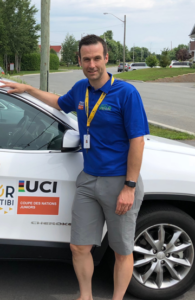
Probably the volunteer who gives the most of his time, before and during the Tour: Bruno Gauthier is the heart of the technical team. Once the management of the Tour has accepted his suggestion as to the route of the 667.4 km of the competition, he must ride it, note the mileage, point out the landmarks and the peculiarities, then work with municipal public works and the Ministry of Transport to ensure that emergency road works are carried out in time, again for the safety of runners. In addition, he is omnipresent during all the events of the Tour. Phew! What a task!
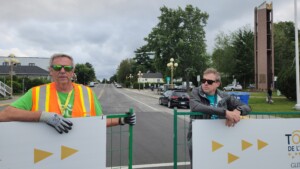
Jacques Pelletier, on the left in the photo, is appointed to security and logistics. We see him here busy with Michel Thériault, opening the gates to allow the evacuation of the caravan that follows the runners in time. Michel is assigned to accreditation, but he is rather multitasking, ready to serve there and when the Tour needs attentive presence.
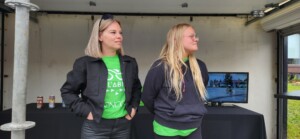
Dignitaries, sponsors and partners as well as members of the Tour’s organizing committee have their designated place to attend the races. Sisters Karina and Valérie Lafrenière have the task of serving them refreshments – which they do with obvious pleasure.
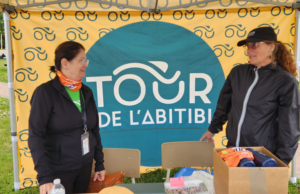
Spectators sometimes wish to acquire souvenirs from the Tour, so Manon Frenoy and Florence Aylwin are there to serve them, in addition to their welcoming work they do at the Tour’s headquarters, at Carrefour school in Val-d’Or.
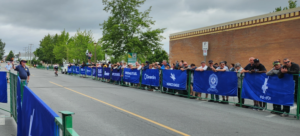
Here is a group of people very important for the runners: the public. The encouragement and congratulations of spectators are important to these young people who need to be appreciated for their efforts, past and present.

Security has taken another dimension in Malartic. To interrupt the traffic on Rue Royale, which is in fact Route 117, the firefighters placed their truck across the street, which also allowed to quickly end this interruption once the riders passed.
The list of people involved in the Tour is long and this article could cover several more pages. We’re saving for next year.
-30-
